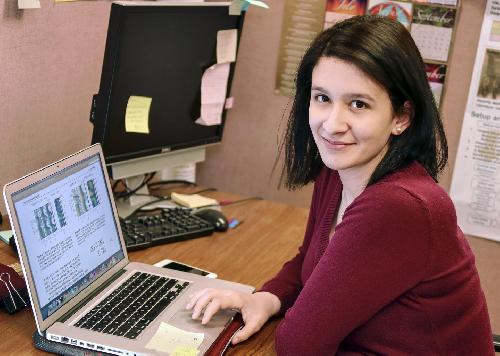Imène Goumiri, a Princeton University graduate student, has worked with physicists at the U.S. Department of Energy's (DOE) Princeton Plasma Physics Laboratory (PPPL) to simulate a method for limiting instabilities that reduce the performance of fusion plasmas. The more instabilities there are, the less efficiently doughnut-shaped fusion facilities called tokamaks operate. The journal Nuclear Fusion published results of this research in February 2016. The research was supported by the DOE's Office of Science.
The new method uses feedback from sensors for real-time control of the rotation of plasma that swirls within a tokamak and fuels fusion reactions. Goumiri, a student in the Princeton Department of Mechanical and Aerospace Engineering, led the design of a controller that employs two different kinds of actuators. The first provides a torque -- or twisting force that causes rotation -- by injecting high-energy neutral particles into the plasma. The second uses a tokamak's three-dimensional coils to create a magnetic field that generates a torque by acting as a drag on the rotation and slowing it down.
Goumiri built a model of plasma rotation from data collected from PPPL's National Spherical Torus Experiment (NSTX) before it was upgraded, and used it to construct the program in MATLAB software. She then translated the program into a predictive model based on PPPL's TRANSP code, the global standard for analyzing plasma performance. The TRANSP model found the new approach to be effective at controlling rotation.
 Imène Goumiri led the design of a controller. Credit: Elle Starkman/PPPL Office of Communications
Imène Goumiri led the design of a controller. Credit: Elle Starkman/PPPL Office of Communications
"This confirmed the validity of our model and the efficacy of the controller," said Goumiri, the lead author of the paper. Coauthors included Clarence Rowley, Princeton professor of mechanical and aerospace engineering, and David Gates, principal research physicist at PPPL and stellarator physics leader, who served as her academic advisors; and Steve Sabbagh, senior research scientist and adjunct professor of applied physics at Columbia University on long-term assignment to PPPL, a member of her doctoral committee who served as a scientific advisor.
The new program, which adapts quickly to feedback from the plasma, draws on the fact that rotating different sections of a plasma at different speeds creates a force called "shear" that lessens instabilities. Rotation can also disrupt transport, a process that leaks heat from the plasma and interferes with fusion reactions.
A unique aspect of the new model is its use of three-dimensional magnetic fields to manipulate the torque produced by the neutral beam injector. The drag created by these magnetic fields, technically known as "neoclassical toroidal viscosity," gives researchers more precise and continuous control of the plasma rotation.
Looking ahead, researchers noted that the upgraded NSTX, called the National Spherical Torus Experiment-Upgrade (NSTX-U), has a second neutral beam injector that can affect a broader region toward the edge of the plasma. This broadened region could alter the shear and enable greater control of plasma instabilities.
Researchers also noted that this new class of controllers can be developed from simulations based on experimental data, with no need for additional experiments for calibration. The new method could replace classical controllers like proportional-integral-derivative (PID) systems, which use experiments to tune their parameters. The new method would necessitate fewer experiments and would provide a way to predict requirements for adjusting plasma rotation in future fusion facilities.
source: DOE/Princeton Plasma Physics Laboratory